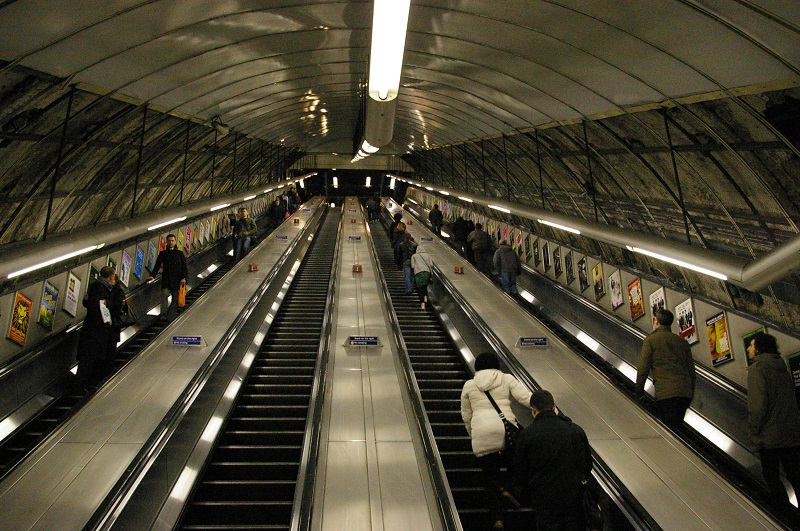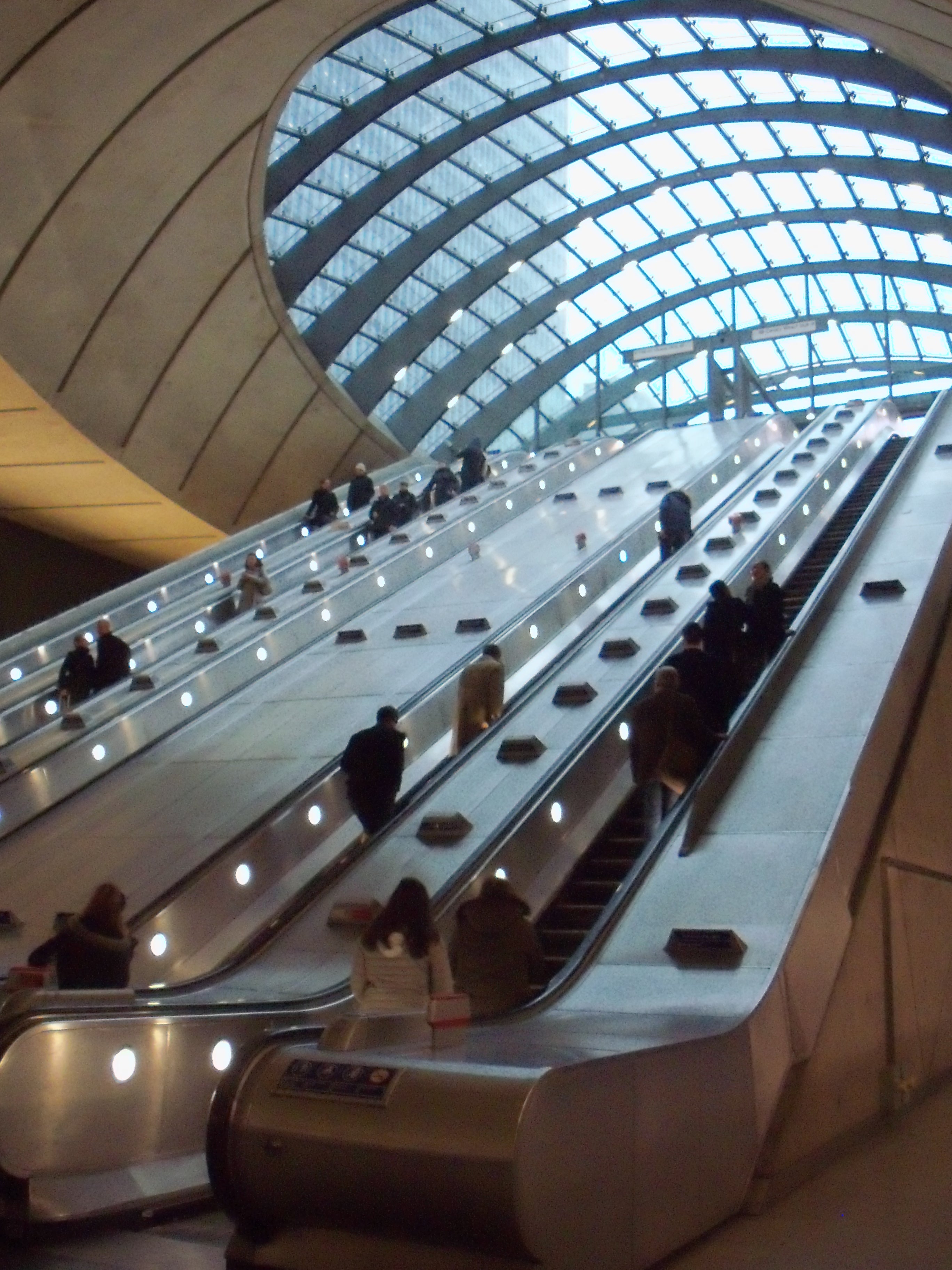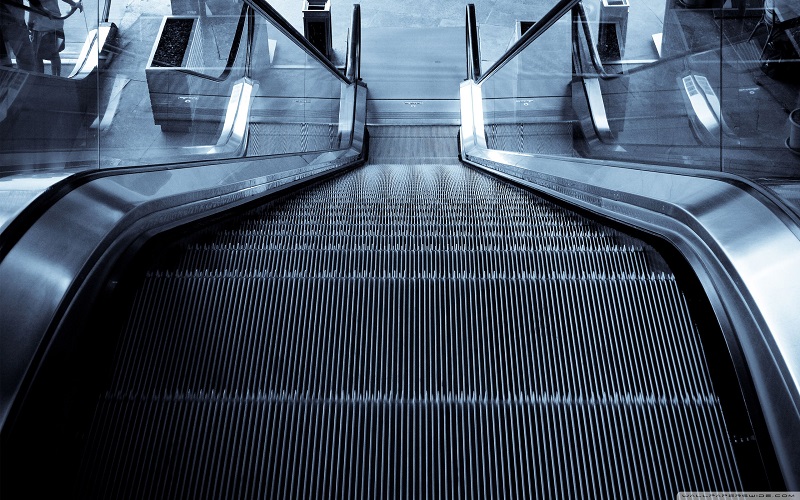Escalator
Contents |
[edit] Introduction
Escalators are mechanical devices used for transporting people vertically between different levels of buildings. Typically, they take the form of a moving staircase, consisting of a 'chain' of single-piece aluminium or stainless steel steps guided by a system of tracks in a continuous loop.
Escalators are commonly used in buildings where the movement of a large number of people is required, such as shopping centres, airports, transit systems, exhibition halls, hotels, arenas, public buildings, and so on.
They occupy the same physical space as a staircase, generally have no waiting time (other than during periods of congestion), allow a greater flow of people, and can be more practical than lifts. It is also possible for people to walk up or down escalators, if they are in a hurry, or if they break down.
A variation of the escalator is the moving walkway, which transports people horizontally.
[edit] History
The first escalator was patented by two Americans, Leamon Souder and Nathan Ames, in the mid-19th century. However, their patented designs were never manufactured.
It wasn’t until the early-20th century that a working prototype designed by Charles Seeburger and Jesse Reno was produced. Their working model gained a lot of attention and was first installed in New York City’s department stores. In 1910, Seeburger and Reno sold their invention to the Otis Elevator Company.
[edit] Speed
The speed of escalators is constant and is generally around 0.3-0.6 m (1-2 ft) per second. This translates to around 27-55 m (90-180 ft) per minute. An escalator moving an average of 44 m (145 ft) per minute can transport over 10,000 people per hour, which is a considerably higher capacity than a standard lift system.
[edit] Configurations
There are three basic configurations that are used for most common escalator systems:
- Parallel: Escalators positioned side-by-side, moving in opposite directions.
- Criss-cross: Escalators moving in one direction are ‘stacked’, minimising space requirements.
- Multiple parallel: A bank of two or more escalators, with differing directions.
[edit] Design considerations
There a number of factors that affect the design of escalator systems, including:
- The vertical and horizontal distance to be spanned.
- The location.
- Other building infrastructure.
- Traffic patterns.
- Carrying capacity.
- Safety considerations.
- Aesthetic preferences.
[edit] Escalator components
The following components make up an escalator system:
[edit] Landing platforms
These contain the curved sections of the tracks, in addition to the gears and motors. The floor plate provides space for users to stand before stepping onto the moving steps. The comb plate has a series of cleats (like the teeth of a comb), that mesh with matching cleats on the edges of the steps and minimise the gap between the stair and the landing.
[edit] Truss
The structure that bridges the lower and upper landings, and carries the straight track sections. Steel or concrete supports connect the ends of the truss to the top and bottom landing platforms.
[edit] Balustrade
This is the structure supporting the handrail of the escalator and can be made of metal, sandwich panels or glass.
[edit] Handrail
The handrail moves courtesy of a chain connected to the main drive gear by a series of pulleys. It is generally made from a blend of synthetic polymers and rubber, and is designed to be very durable.
[edit] Tracks
The step-wheel track for the front wheels of the steps, and the trailer-wheel track for the back wheels of the steps, cause the steps to form a staircase as they move from under the comb plate.
[edit] Steps
These are typically solid and made of die-cast aluminium or steel. They are cleated with comb-like protrusions that mesh with the comb plates. The steps are linked by a continuous metal chain that forms a closed loop.
The steps, connected in series, always step level as they move. The steps create a flat platform at both the top and the bottom of the escalator by collapsing on each other. This works by way of the two sets of wheels on each step. The upper set of wheels are connected to the rotating chains, pulled by the gears at the top of the escalator. The lower set of wheels follow behind and just glide along on their track.
[edit] Motor
Escalators are driven by a motor and chain system inside the truss. At its core are a pair of chains looped around two pairs of gears. The gears at the top of the escalator are turned by an electric motor, which in turn rotates the chain loops. The electric motor also powers the moving handrail which is looped around a series of wheels and is configured so that it moves at a similar speed to the steps.
[edit] Related articles on Designing Buildings Wiki
Featured articles and news
Delivering for tenants; National Retrofit Hub
New report offers recommendations to strengthen energy efficiency standards to protect private renters.
Government consultations for the summer of 2025
A year of Labour, past and present consultations on the environment, the built environment, training and tax.
CMA competitiveness probe of major housing developers
100 million affordable housing contributions committed with further consultation published.
Homes England supports Greencore Homes
42 new build affordable sustainable homes in Oxfordshire.
Zero carbon social housing: unlocking brownfield potential
Seven ZEDpod strategies for brownfield housing success.
CIOB report; a blueprint for SDGs and the built environment
Pairing the Sustainable Development Goals with projects.
Types, tests, standards and fires relating to external cladding
Brief descriptions with an extensive list of fires for review.
Latest Build UK Building Safety Regime explainer published
Key elements in one short, now updated document.
UKGBC launch the UK Climate Resilience Roadmap
First guidance of its kind on direct climate impacts for the built environment and how it can adapt.
CLC Health, Safety and Wellbeing Strategy 2025
Launched by the Minister for Industry to look at fatalities on site, improving mental health and other issues.
One of the most impressive Victorian architects. Book review.
Common Assessment Standard now with building safety
New CAS update now includes mandatory building safety questions.
RTPI leader to become new CIOB Chief Executive Officer
Dr Victoria Hills MRTPI, FICE to take over after Caroline Gumble’s departure.
Social and affordable housing, a long term plan for delivery
The “Delivering a Decade of Renewal for Social and Affordable Housing” strategy sets out future path.
A change to adoptive architecture
Effects of global weather warming on architectural detailing, material choice and human interaction.
The proposed publicly owned and backed subsidiary of Homes England, to facilitate new homes.
How big is the problem and what can we do to mitigate the effects?
Overheating guidance and tools for building designers
A number of cool guides to help with the heat.
The UK's Modern Industrial Strategy: A 10 year plan
Previous consultation criticism, current key elements and general support with some persisting reservations.
Building Safety Regulator reforms
New roles, new staff and a new fast track service pave the way for a single construction regulator.




























